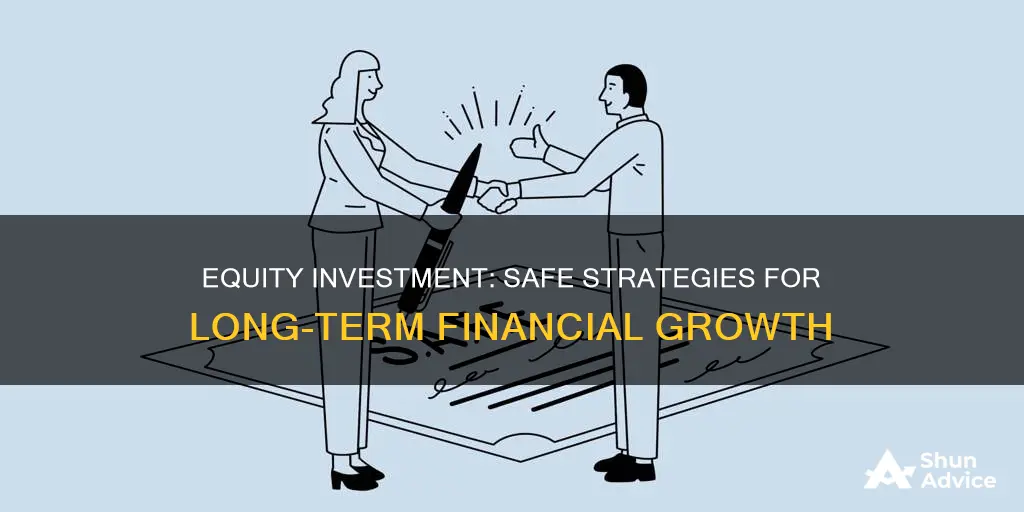
Safe equity investment refers to a Simple Agreement for Future Equity (SAFE), a legal contract between a startup and an investor that allows the investor to purchase equity in the company at a future date. SAFEs were introduced in 2013 as an alternative to convertible notes, which are short-term debt instruments that convert to equity upon a predetermined event. Unlike convertible notes, SAFEs are not debt instruments and do not accrue interest or have a maturity date, making them more appealing for startups that want to avoid debt and immediate shareholder obligations. The primary trigger for the conversion of a SAFE into equity is typically the sale of preferred shares by the company during a future priced funding round. SAFEs are intended to provide a simpler mechanism for startups to seek initial funding and can be structured to lower equity dilution for founders compared to traditional equity financing. However, as with any investment, there are potential drawbacks and risks associated with SAFEs, including unexpected dilution and voting control issues.
What You'll Learn

Simple Agreement for Future Equity (SAFE)
A Simple Agreement for Future Equity (SAFE) is a financing contract between a startup and an investor. It allows the investor to purchase equity in the company at a future date, typically during the company's next priced round or during a liquidity event. SAFEs were first introduced in 2013 as an alternative to convertible notes.
SAFEs are often used by startups to raise capital in their seed financing rounds. They are a more founder-friendly option as they do not accrue interest or have a maturity date, making them an attractive fundraising option for early-stage startups. The startup accelerator Y Combinator introduced the SAFE in late 2013, and it has since been used by many startups as the main instrument for early-stage fundraising.
A SAFE operates as a legal contract. Key terms like a valuation cap or discount rate incentivize investors with the opportunity to receive shares at a favourable price when the SAFE converts into shares. For instance, if the SAFE investors enjoy a 20% discount and investors in the subsequent round of financing purchase preferred shares at $1 per share, the SAFE investors would only pay $0.80 per share. The higher the discount rate, the more equity SAFE investors would receive for their investment.
SAFEs are also flexible and can be structured to lower equity dilution compared with traditional equity financing, enabling founders to keep more control over the company. They are typically shorter and less complex than traditional equity or debt financing documents, which speeds up the negotiation process. This enables startups to focus on their business rather than lengthy funding negotiations. SAFEs also often have customizable terms that can be tailored to fit the specific needs of the startup and its investors.
However, it is important to note that SAFE investors have no voting rights or ownership in the company until the SAFE converts. If the triggering event never occurs, a SAFE investor can be left with nothing.
Partial Investment: Impact on Alpha and Portfolio Performance
You may want to see also

Pros and cons of SAFE
SAFE, an acronym for Simple Agreement for Future Equity, is a legal contract between a startup and an investor that allows the investor to purchase equity in the company at a future date. This agreement is used by startups to receive funding without determining a valuation or issuing equity immediately.
Pros of SAFE:
- SAFEs are typically shorter and less complex than traditional equity or debt financing documents, which speeds up the negotiation process.
- SAFEs have customizable terms that can be tailored to fit the specific needs of the startup and its investors. This flexibility includes valuation caps and discount rates, allowing startups to negotiate terms that align with their growth strategy and funding needs.
- SAFEs can be structured to lower equity dilution compared with traditional equity financing, enabling founders to keep more control over the company.
- SAFEs are not debt instruments and don't accrue interest, helping startups avoid the pressure of accumulating debt and the obligation of making repayments.
- The primary attraction of a SAFE for investors is the potential for high returns. If the startup succeeds, its equity could appreciate substantially.
- SAFEs are flexible, as they don't carry interest or have a maturity date, which makes them more appealing for startups that want to avoid debt or immediate shareholder obligations.
- SAFEs can include provisions that give early investors some priority over future investors, such as early access to new shares or discounts in future rounds, attracting investors looking to maximize their investment benefits.
Cons of SAFE:
- SAFEs may include uncertainty about what the cap table looks like, as it's difficult to determine how many shares or how much ownership the SAFEs will convert into.
- SAFEs may lose the opportunity to set a document precedent with the earliest investors, whose interests may be more aligned with the company than later investors.
- SAFEs may be harder to attract investors as they have no maturity date, and investors don't get many rights or ownership in exchange for their investment.
- SAFEs may lead to higher legal fees and more paperwork, taking longer for any additional investors in later closings to review and sign.
- SAFEs may impact the 409A FMV and, therefore, raise the option exercise price.
- SAFEs may never convert to equity if the company never raises another round.
REITs: A Safe Investment Bet or Risky Business?
You may want to see also

How SAFE compares to convertible notes
A Simple Agreement for Future Equity (SAFE) is a legal contract between a startup and an investor that allows the investor to purchase equity in the company at a future date. SAFEs were introduced in 2013 as an alternative to convertible notes.
SAFE notes and convertible notes are two types of convertible securities, or convertible instruments, that startups can use to raise capital. Both are agreements between a startup and an investor that allow the investor to purchase equity in the company at a future date. However, there are several differences between the two.
Firstly, SAFE notes are not debt instruments and do not accrue interest, whereas convertible notes are considered debt and have an interest rate. This means that SAFE notes are more attractive to startups as they avoid the pressure of accumulating debt and the obligation of making repayments.
Secondly, SAFE notes are typically shorter and less complex than convertible notes, which speeds up the negotiation process. This enables startups to focus on their business rather than lengthy funding negotiations. SAFE notes are also more flexible, as they don't carry interest or have a maturity date.
Thirdly, SAFE notes and convertible notes have different conversion times. SAFE notes convert into equity during the next priced round, regardless of how much money the company raises. On the other hand, convertible notes typically convert into equity only when a certain amount of capital is raised in a priced round.
Another difference is that SAFE notes do not rely on a valuation, making them suitable for very early-stage companies that may not have a value yet. In contrast, convertible notes are based on a negotiated valuation of the company.
Finally, SAFE notes can be structured to lower equity dilution compared to traditional equity financing, enabling founders to keep more control over the company.
Investment Bankers: Model-Making Masters or Scratch-Building Slaves?
You may want to see also

How to get started with SAFE
A Simple Agreement for Future Equity (SAFE) is a legal contract between a startup and an investor that allows the investor to purchase equity in the company at a future date. SAFEs are typically used by startups to receive funding without determining a valuation or issuing equity immediately.
Understand the Basics
Firstly, it is important to understand how SAFE works. A SAFE agreement is a type of convertible instrument, which means it can be converted into equity at a particular time. However, unlike traditional equity or debt financing, a SAFE does not accrue interest or have a maturity date. This makes it a more attractive option for early-stage startups as it helps them avoid debt and immediate shareholder obligations.
Identify the Type of SAFE
There are two main types of SAFE agreements: pre-money and post-money. The key difference between the two is how the company's value is determined. A pre-money SAFE does not set a fixed ownership percentage for the investor, making it more "founder-friendly." On the other hand, a post-money SAFE locks in the investor's ownership percentage upfront, providing more clarity for both the company and the investor.
Determine the Key Terms
When issuing SAFEs, it is important to consider key terms such as valuation caps and discount rates. A valuation cap sets the maximum value in equity that can be obtained in the agreement. The cap is designed to reward early investors for taking on more risk. Discount rates, on the other hand, incentivize investors by offering them the opportunity to receive shares at a favourable price when the SAFE converts into shares.
Consider the Benefits and Risks
SAFEs offer several advantages for both startups and investors. They are typically shorter and less complex than traditional financing documents, speeding up the negotiation process. SAFEs also provide flexibility, allowing startups to negotiate terms that align with their growth strategy and funding needs. Additionally, the potential for high returns attracts investors to SAFEs. However, it is important to note that converting SAFEs into equity during subsequent funding rounds can dilute the founders' stakes later on.
Consult Legal Professionals
As SAFE is a legal contract, it is always advisable to seek legal advice when drafting or reviewing the agreement. Consulting with legal professionals can help ensure that the terms of the SAFE agreement are fair and compliant with relevant regulations.
Unlocking Home Equity: My Investment Journey
You may want to see also

SAFE and tax implications
A Simple Agreement for Future Equity (SAFE) is a legal contract between a startup and an investor that allows the investor to purchase equity in the company at a future date. SAFEs were introduced in 2013 as an alternative to convertible notes, which are considered debt instruments and come with interest rates and maturity dates. SAFEs, on the other hand, do not accrue interest or have a maturity date, making them more appealing to startups that want to avoid debt.
When it comes to tax implications, the IRS may treat a SAFE as equity or as an equity derivative for tax purposes. The precise tax treatment of a SAFE can significantly impact an investor's returns and should be considered before striking a deal. There has been a debate among tax professionals over the years regarding whether a SAFE should be treated as stock, debt, or a hybrid contract instrument for federal income tax purposes.
In the context of a "variable prepaid forward contract" tax treatment, there are no immediate tax consequences for the company or the investor when issuing a SAFE. The SAFE is not considered an equity issuance or ownership in the company, and the proceeds from investors are simply a liability on the company's balance sheet. However, the downside of this treatment is that the holding period of the investors' equity interest is delayed until conversion on the triggering date.
Alternatively, a SAFE can be treated as an equity grant, owning part of the company (shares of stock) for tax purposes. If a SAFE is treated as stock for federal income tax purposes, it should also be treated as stock for specific sections of the tax code, and the holding period for tax purposes would commence when the SAFE is issued, even if it has not yet converted into preferred stock.
It is important to note that holding SAFEs does not equate to owning part of the company. SAFEs typically do not provide voting rights, the right to dividends, or the right to share in profits or losses. Therefore, the tax consequences of a SAFE investment may differ from those of traditional equity investments.
Robinhood Investing: Diversifying Your Portfolio for Beginners
You may want to see also
Frequently asked questions
SAFE stands for Simple Agreement for Future Equity. It is a legal contract between a startup and an investor that allows the investor to purchase equity in the company at a future date.
A SAFE agreement does not rely on a valuation. Instead, investors and the company negotiate the mechanism by which future shares will be issued, and defer actual valuation. The precise conditions of a SAFE vary, but the basic mechanics are that the investor provides funding to the company at signing in return for stock in the company at a later date.
SAFEs are typically shorter and less complex than traditional equity or debt financing documents, which speeds up the negotiation process. They are also flexible, as they don’t carry interest or have a maturity date, which makes them more appealing for startups that want to avoid debt or immediate shareholder obligations.







